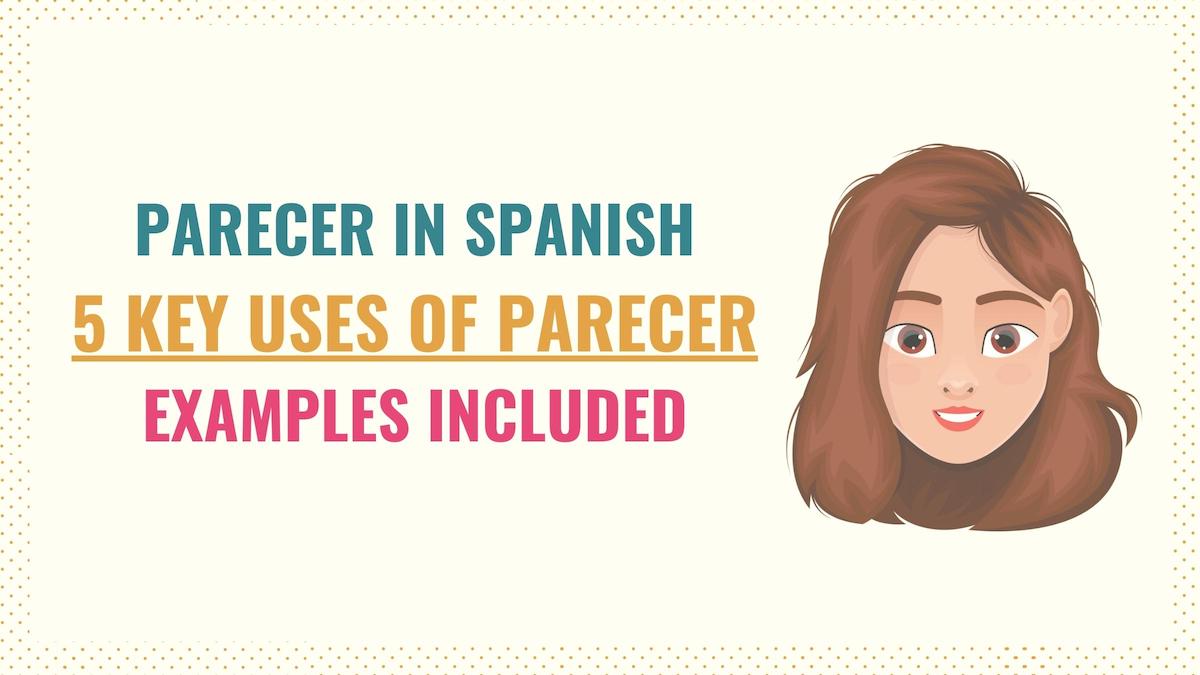Many people assume that parecer is the direct translation of ‘to seem’ or ‘to appear’. And this is true. But besides this, this verb has other meanings and applications. As a result, when people see this verb applied in different contexts, they wonder how to use ‘parecer’.
‘Parecer’ is used to ask and give opinions, talk about people’s resemblances, express assumptions, show agreement, or talk about looks and appearances. Depending on the context, ‘parecer’ means:
- Sounds good
- To think / to find
- It seems / it appears / it looks like
- Apparently
- To look like / To look alike
‘Parecer’ and its different meanings are very useful in daily conversations. As a result, in this article, we’ll explore the most common ways you can this verb. In fact, this is what we’ll cover:
How to Use ‘Parecer’ in Spanish
The verb ‘parecer’ is linked to perception. This means that we use it to talk about resemblances, describe the way things and people look, show agreement about something and express opinions.
In the sections below, I’ll show you the phrase structures you need to use in each one of these contexts.
1. Asking and expressing opinions
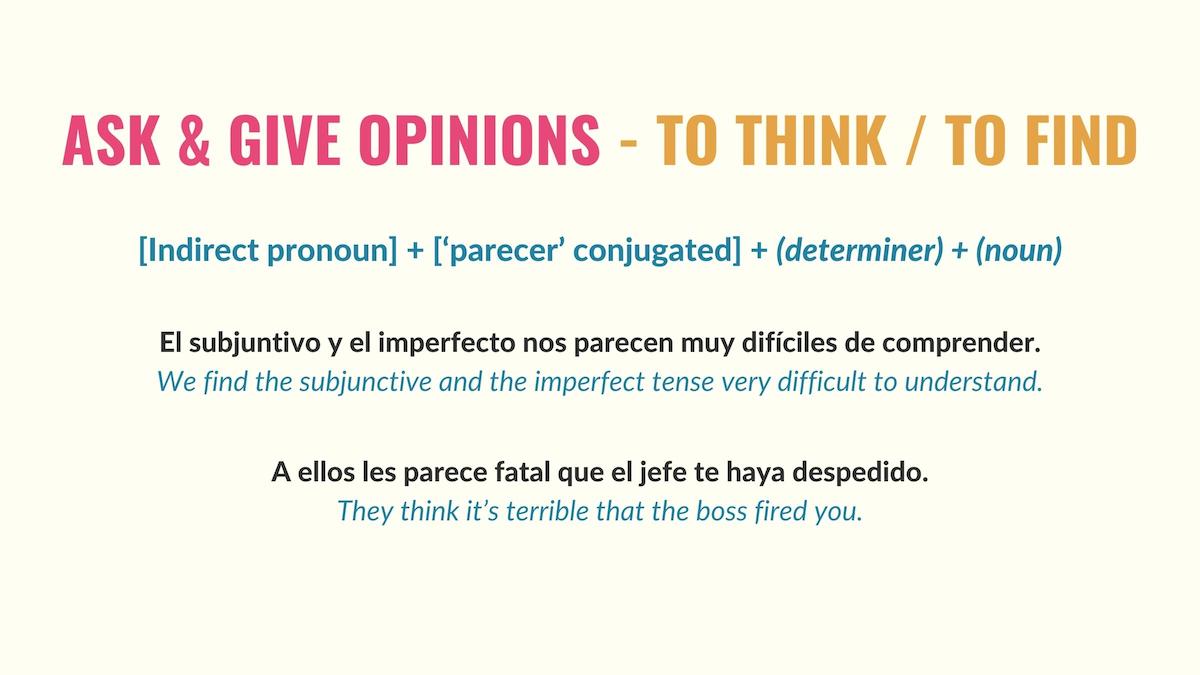
One of the most common uses of this verb is to ask and give opinions about a certain topic or activity. So, in this situation, ‘parecer’ means ‘to think’ or ‘to find’. With this meaning, there are certain rules that you need to follow:
- Follow the ‘gustar’ conjugation rules. So, depending on the topic or activity you’re talking about, you can only conjugate this verb in the third person singular or plural (parece or parecen).
- This verb can be conjugated to any tense (past, present, future, etc) you need.
- An indirect pronoun precedes the verb. This pronoun needs to match the person who is giving the opinion.
Okay, let’s put these rules to work with some examples. Notice that you can use this structure to either ask or give your opinion:
[Indirect pronoun] + [‘parecer’ conjugated] + (determiner) + (noun)
Chris, ¿qué te parece el libro que te presté?
Chris, what do you think about the book that I lent you?
¿Qué le parecieron a tu mamá las blusas que le regalaste?
What did your mom think about the blouses you gave her?
La maestra nueva me parece muy buena para enseñar.
I think the new teacher is very good at her work.
La verdad, me pareció una película muy mala.
To be honest, I think it was a really bad movie.
A ellos les parece fatal que el jefe te haya despedido.
They think it’s terrible that the boss fired you.
El subjuntivo y el imperfecto nos parecen muy difíciles de comprender.
We find the subjunctive and the imperfect tense very difficult to understand.
Notice that you can give your opinion about an object, but also about an action (like we did in example #5).
2. To Talk About Resemblances
Another common way to apply ‘parecer’ in Spanish is to talk about physical similarities and resemblances between two or more people. In this case, we need to use the reflexive form parecerse which means ‘to look like’ or ‘to look alike’.
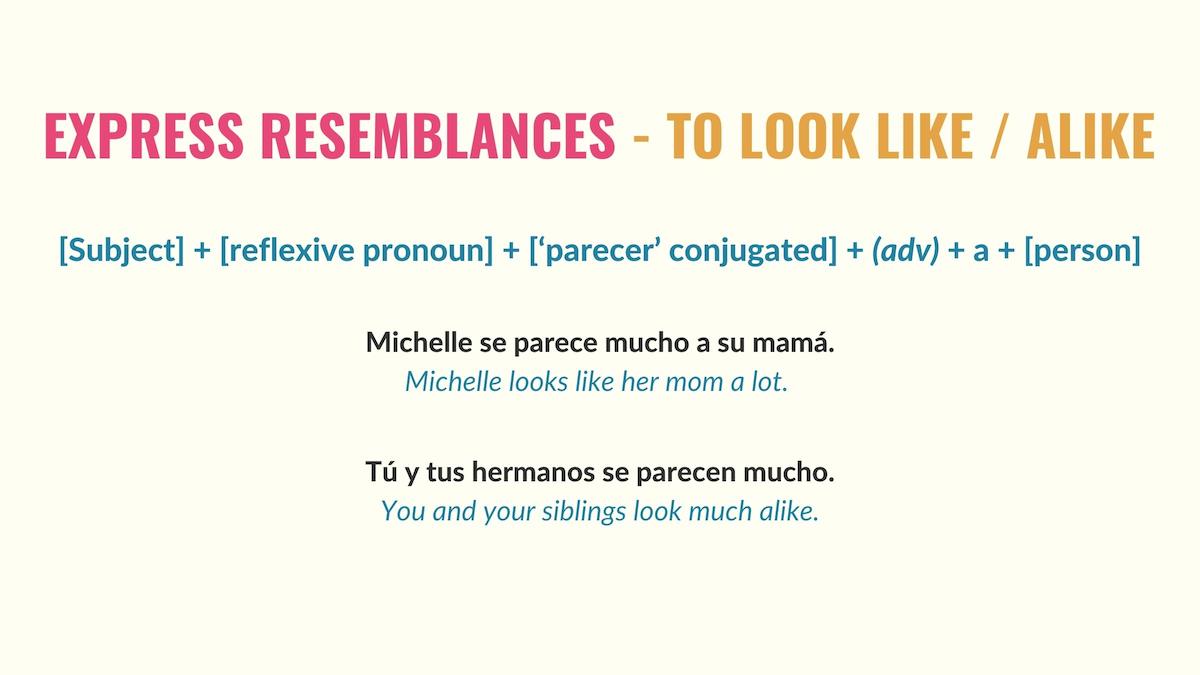
Here are some examples, as well as the phrase structure you will need to use:
[Subject] + [reflexive pronoun] + [‘parecer’ conjugated] + (adv) + a + [person]
Michelle se parece mucho a su mamá.
Michelle looks like her mom a lot.
¡Qué onda! Te pareces un montón a tu hermana.
What the heck! You look a lot like your sister.
No me parezco a mis papás, me parezco más a mis tías.
I don’t I look-alike to my parents; I look more like my aunts.
Use adverbs of quantity if you want to express how much a person looks like another:
Tú y tus hermanos se parecen mucho.
You and your siblings look much alike.
Sebastián y Alicia se parecían mucho cuando eran niños.
Sebastian and Alicia looked much alike when they were little.
Take Note: Parecido is this verb’s noun or past participle form. It means ‘similar’ or ‘resemblance’.
3. To Talk about Someone’s Appearance or Look
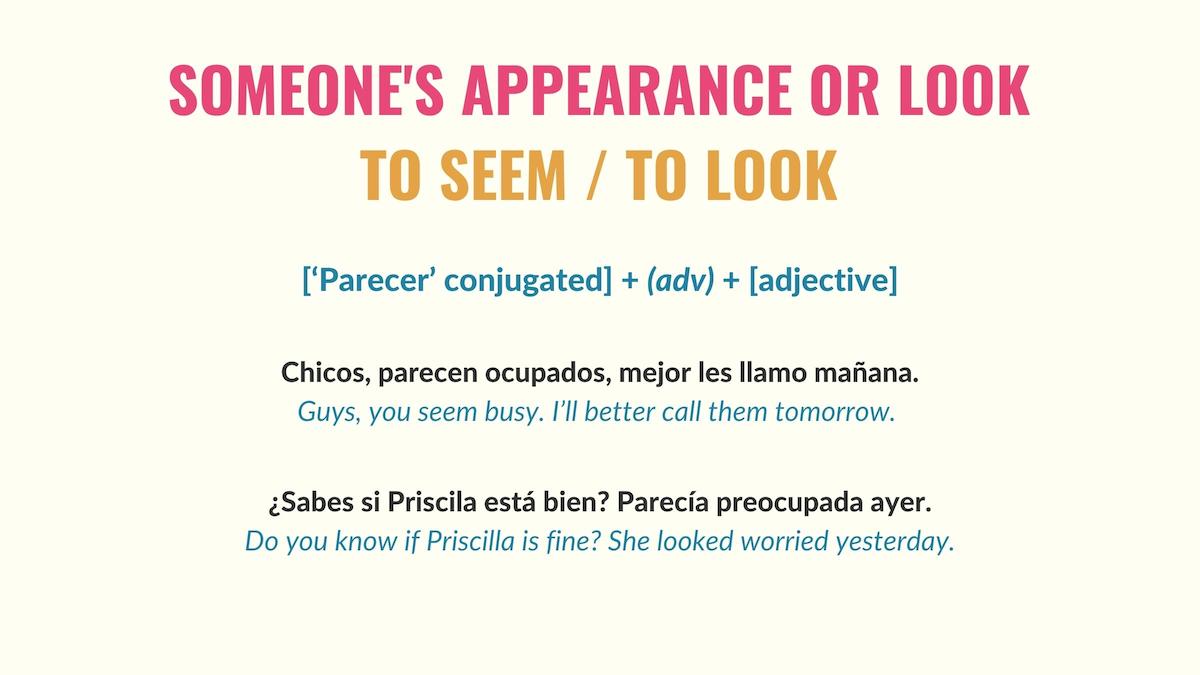
‘Parecer’ can also be used to talk about people’s appearance and looks. In this context, we can use this word to describe physical appearance, but also emotional states and personality. Given this meaning, in this situation, ‘parecer’ is the direct translation of ‘to seem’ or ‘to look’.
[‘Parecer’ conjugated] + (adv) + [adjective]
¿Estás bien? Pareces un poco triste.
Are you okay? You seem a bit sad.
Chicos, parecen ocupados, mejor les llamo mañana.
Guys, you seem busy. I’ll better call them tomorrow.
¿Sabes si Priscila está bien? Parecía preocupada ayer.
Do you know if Priscilla is fine? She looked worried yesterday.
La chica nueva parece agradable, pero todavía no he hablado con ella.
The new girl seems nice, but I haven’t talked to her yet.
4. To Express Assumptions
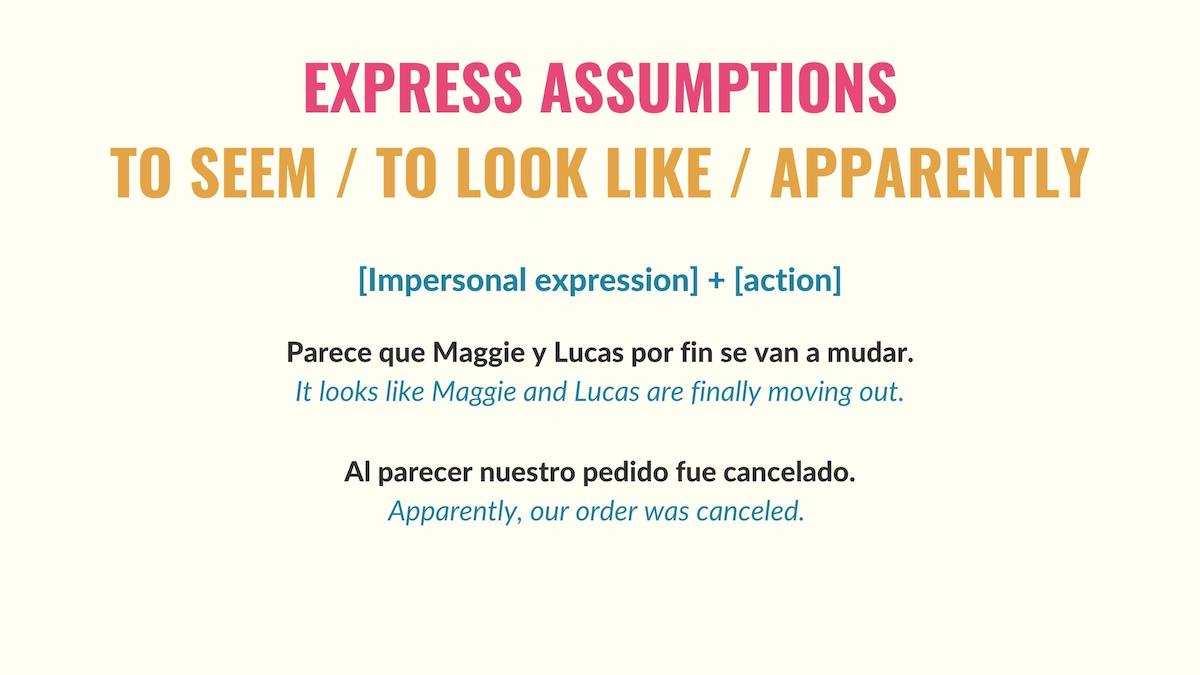
You can also use this verb as a way to share some information that we assume based on what we see or know. As a result, in this context, this verb could be translated as:
- It seems
- Apparently
- It looks like
Unlike other meanings of ‘parecer’, for this situation, you’ll need to use this verb in its impersonal form (without indicating who the subject is). Here are some examples of impersonal forms of ‘parecer’:
- Parece que
- Al parecer
[Impersonal expression] + [action]
Llévate un paraguas, parece que va a llover.
Take an umbrella, it seems that it’s going to rain.
Parece que Maggie y Lucas por fin se van a mudar.
It looks like Maggie and Lucas are finally moving out.
¿Ya supiste? Parece que despidieron a Eva.
Did you hear? It seems that Eva was fired.
Al parecer nuestro pedido fue cancelado.
Apparently, our order was canceled.
Take Note: Both ‘parece que’ and ‘al parecer’ are used to introduce the assumption people are making.
5. To Show Agreement
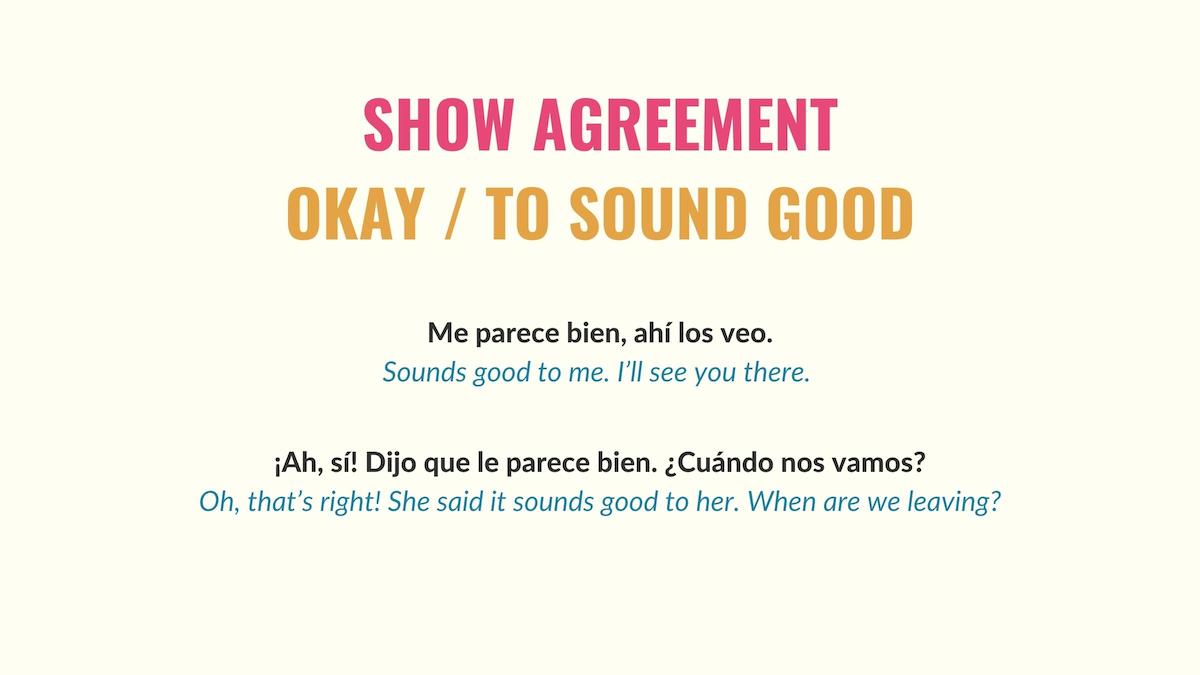
‘Parecer’ to show our agreement with people’s suggestions or proposals. This use of ‘parecer’ is quite common in conversations where people are discussing the details of some activity they plan to do together.
In this context, this Spanish verb means ‘sounds good’ and it’s usually applied as a response to someone’s proposal or statement. To create this meaning, you need to use indirect object pronouns. Here are some examples:
| Spanish | English |
|---|---|
| Tu amigo: Oye, nuestro avión sale a las seis de la mañana, quedamos de vernos a las cuatro en el aeropuerto. | Your friend: Hey, our plane leaves at six in the morning, we agreed on meeting at the airport at four. |
| Tú: Me parece bien, ahí los veo. | You: Sounds good to me. I’ll see you there. |
| Spanish | English |
|---|---|
| Tu amigo: ¿Le dijiste a Clara sobre el viaje a la playa y los precios? | Your friend: Did you tell Clara about the trip to the beach and the prices? |
| Tú: ¡Ah, sí! Dijo que le parece bien. ¿Cuándo nos vamos? | You: Oh, that’s right! She said it sounds good to her. When are we leaving? |
Key Points: How to Use Parecer Like a Native Speaker
‘Parecer’ is a verb with multiple meanings that can be applied to different situations. Here are some key points that you may want to keep in mind:
- This Spanish word can be used to express agreement, opinions and to talk about a person’s looks or resemblance.
- The impersonal form parece can be used to ask and give opinions, and show agreement. This form follows the same conjugation pattern as ‘gustar’.
- The reflexive form parecerse is used to talk about people’s resemblance.
- ‘Parece que’ and ‘al parecer’ are forms of the verb ‘parecer’ that we use to express assumptions.
Now that you have a better understanding of the contexts where you can use ‘parecer’, you should try to apply it into your conversation, ¿qué te parece? 😉
Download the Parecer Uses PDF
Learning how to use verbs to their fullest will help you sound more fluent. So, I’ve compiled a PDF with all the uses of this Spanish verb so that you can review it and incorporate this verb into your daily conversations with confidence.
Related Resources
Watch the Video Lesson
Watch the Spanish Immersion Lesson!
You can watch the immersion version of this 5 Key Uses of Parecer in Spanish lesson to challenge your comprehension skills.
- How ‘Gustar’ Works: In some of its meanings, the verb ‘parecer’ follows the same conjugation patterns that ‘gustar’. In this article, you can learn more about the rules that you need to keep in mind.
- 100 Adjectives to Describe Someone: This article, we’ll help you learn common adjectives so you can describe people’s appearance or emotional states more accurately.
- How to Conjugate Parecer: In this guide, you’ll learn all of the different conjugations for this spanish verb as well as a conjugation quiz.

